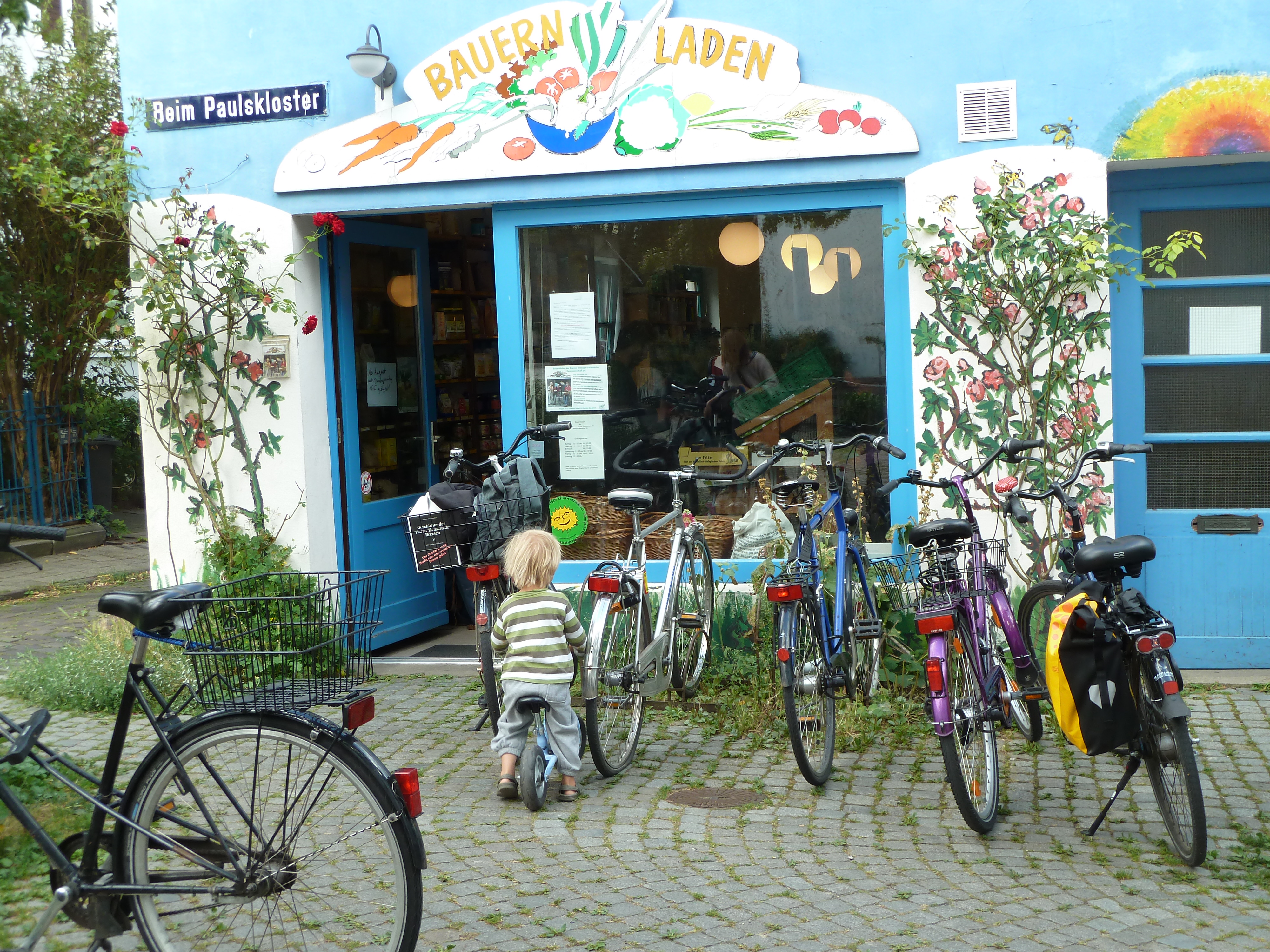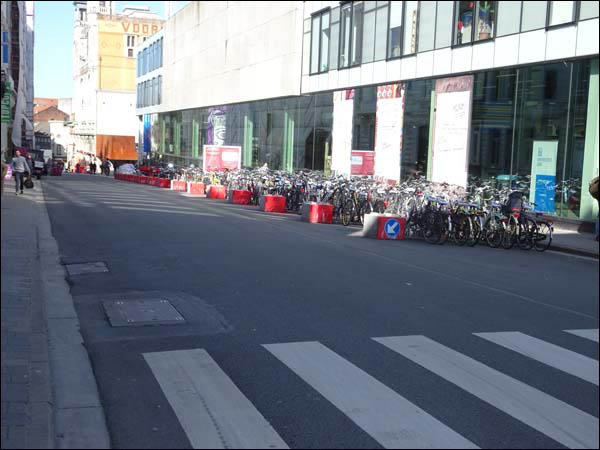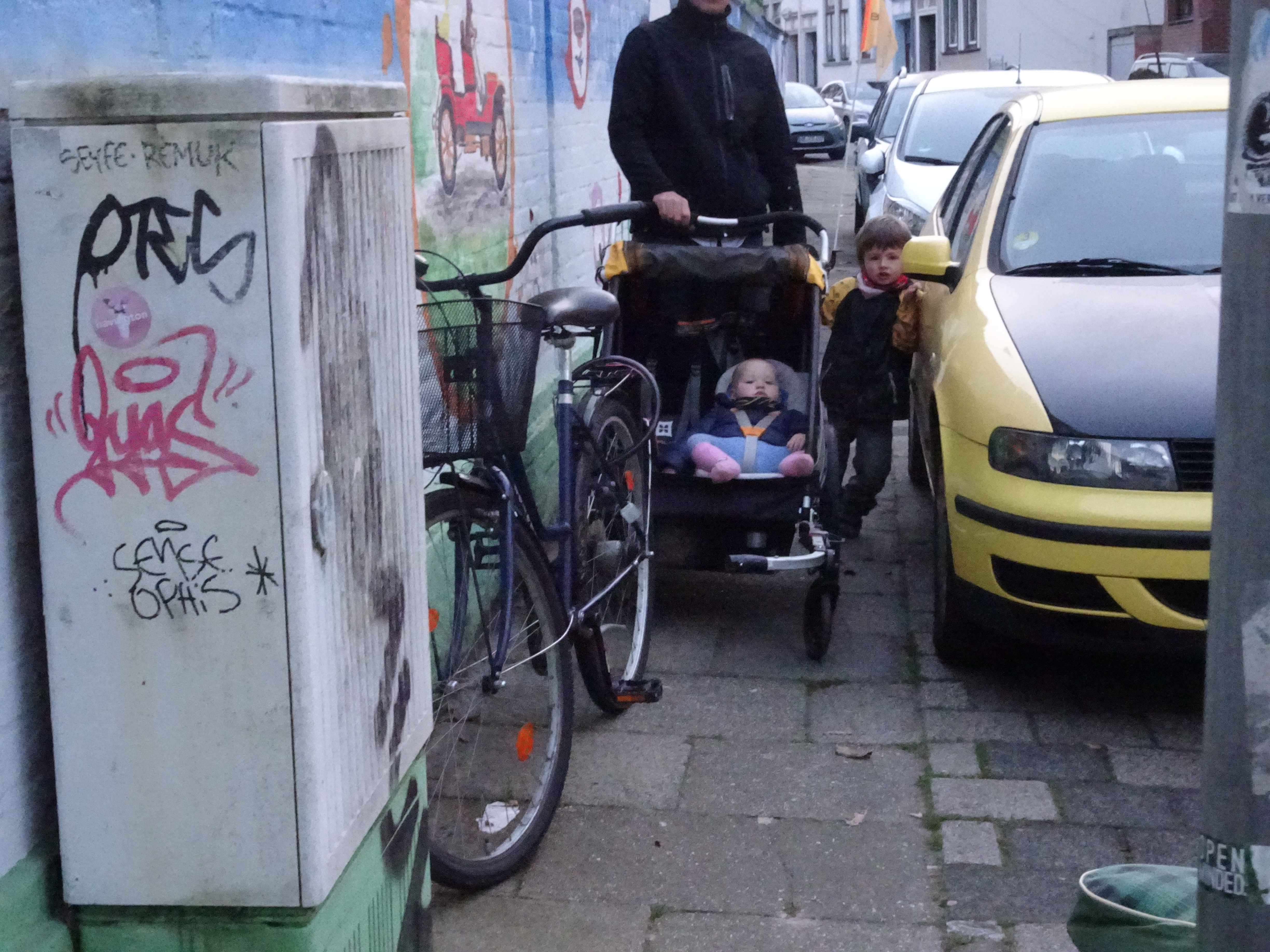The Amsterdam approach to car parking which we previously outlined is also regarded as a model for the European Push & Pull project.

Carfree Parking in Bremen
Push-Pull is essentially a package of carrot and stick policies: I’ll take something away from you, e.g. Free parking, and give you something back, e.g. more trams, quality cycleways, safe pavements.In short: improved quality of life through better mobility.
To quote: “The PUSH & PULL project aims to to improve urban mobility by means of parking space management combined with mobility management .. measures. By introducing paid parking, increasing parking fees, reducing or restraining parking supply or implementing comparable measures, car drivers are pushed to use more sustainable transport. At the same time, (parts of) the income generated from parking space management are used for incentives to promote alternatives, thus pulling or attracting users towards public transport, walking, cycling and other sustainable modes”.
“The main objectives of PUSH & PULL are:
- Saving energy through a modal shift from lightly-occupied car to other, more sustainable modes of transport.
- Identifying and spreading knowledge of ways to make the implementation of parking management measures more politically acceptable; and also by institutionalising parking management as a source of revenue for sustainable transport measures.
- Helping the local economy by promoting parking management and providing advice to local authorities on how to avoid the need for new parking spaces, and thereby achieving cost savings
7 European Cities involved
The project involves the introduction of parking and mobility management in seven cities and one university. In every case, the money generated by parking management will be used to finance sustainable mobility. The participating cities are Ghent in Belgium, Krakow in Poland, Bacău and Iaşi in Romania, Tarragona in Spain, Örebro in Sweden and Nottingham in the UK, as well as the University of Ljubljana in Slovenia.
Our assessment
After reviewing the final report, the following can be said about the cities’ projects:
Push:
Introduce parking management
Cities that are very much in the early stages of any kind of transport transition – Bacău, Jasi, Krakow and Tarragona – are either concentrating on managing parking space in the city centre (Jaşi) or extending it (all others). Tarragona seems to have made the most progress here. Nottingham has introduced a levy on workplace parking, amounting to £379 (2017) per car space and year, that companies have to pay (“Workplace Parking Levy”). The University of Ljubljana is concentrating on the transport choices of its employees: Car parking must now be paid for.
Changes in parking regulations and improve local residents parking
Örebro and Ghent have changed their parking space regulations for all new construction projects. Örebro allows only a quotient of 0.5 (pitches) per apartment. Any new building project must offer a package of alternatives to the car, such as car sharing and bicycle parking. Ghent does not allow any parking spaces on new-build land in the city centre, though little has changed elsewhere in the city. Ghent will not now grant public parking permits to residents who already have their own parking spaces on their new premises. The cityhas also reorganised its existing resident parking schemes, and has digitised the zones in which parking space management is already in operation.

Bicycle parking in Ghent
Pull:
Marketing Sustainable Transport
Nottingham, Krakow, Jaşi and the University of Ljubljana seem to be putting the bulk of their revenues into marketing sustainable transport modes.
More for public transport, cycleways, cycle parking, pedelecs, car sharing
Tarragona promotes public transport and pedestrian traffic. After all, Bacău is seeking to create a cycling network by creating bike lanes on main roads. And there will be a student ticket for public transport (which, according to experience, does not help cycling). Ghent, Örebro and also Krakow are focussing on more cycle parking. For example, Ghent has issued new guidelines according to which, in the future, cycle parking spaces will have to be available to residents no more than 100 metres from each door. Also Örebro has issued new guidelines, and Krakow has announced the construction1000 new bicycle parking spaces. Elsewhere, Örebro has launched a campaign for innovative alternative transportation strategies: pedelecs, car sharing, cycling in winter and an adult cycling school.

Joys of walking in Bremen
A Lax ParkingPolicy – Bremen’s MissedOpportunities
What can Bremen learn from this? For one thing, Bremen coulduse its excellent resources more actively:
- 14,000 CarSharing users and rising, with car-sharing stations being expanded.
- 25% modal share for cycling, but stagnant for 20 years. And now even falling to 23% in 2013
- 700 km of cycleways,but little invested in repair and renewal
- 14% modal share fora pretty comprehensive public transport system that also serves the surrounding countryside
But: 80,000 of around 120,000 commuters travel to Bremen every day by car. There are free parking spaces everywhere. This represents a modal share of around 40%, which, like a monolithic block, hinders the further development of atransport transition. (VEP, p. 31) We are no better off than, for example, Düsseldorf or Leipzig – despite our high share of cycling.
Private cars account for more than 7 million kilometres of driving every day in Bremen (Cf. BUND, Landesverband Bremen (Hrsg.): Mobility for all – instead of right of way for petrol coaches, Bremen 2011). 39% of all Bremers are cyclists who cycle daily, but according to the VEP (Local Transport Plan 2025) we have another potential of around 34% of the people of Bremen who could use their bicycles on a daily basis. Because up to 80% of all journeys in Bremen are shorter than 10 km and 66% shorter than 5 km.
Nonetheless, 26% of the people in Bremen use their cars for journeys under 2 km, 42% also get into the car for journeys under 5 km, and for journeys between 5 and 10 km the modal share cars is a dramatic 57%. (VEP, p.33f)
Bremen is in a great place if it wants to see changes, with cycle and car-sharing infrastructure that other politicians in other cities can only dream of it. But the political will is simply not there. Recent controversies over missed climate change targets, and the rejection of new cycle and pedestrian bridges despite 90% funding from Berlin, suggest a frustrated Green Transport Senator being largely ignored by his SPD coalition partners. With elections looming next year, it remains to be seen whether attitudes will change.
A grand coalition of four environmental NGOs (BUND, ADFC, VCD and FUSS e.V.) have just come up with a proposal to start managing the chaotic parking situation in Bremen. Does the local government listen? Do they want any change?
Breaking News: The Green Transport Senator has recently declared that he will not stand for election in 2019.
There will be an event about this project: 13. September 2018
1 thought on “European Push and Pull”
Comments are closed.